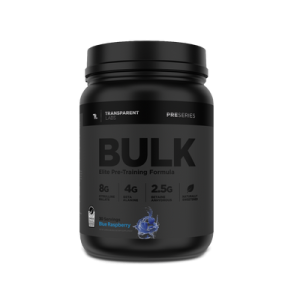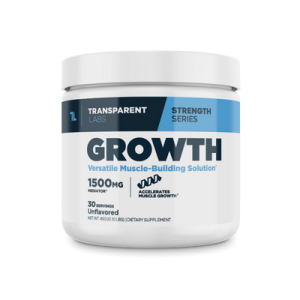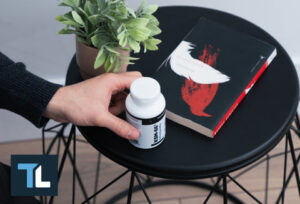
Using Peptides for Muscle Growth and Fat Loss: Benefits vs. Risks
Written by Elliot Reimers, M.S.(C), CISSN, CNC
Last updated on Aug 18, 2024

More athletes, bodybuilders, and gym-goers have taken an interest in using peptides for muscle growth, fat loss, and even increasing appetite when bulking. The main peptides used to increase lean muscle mass and enhance body composition are growth hormone secretagogues, specifically growth hormone-releasing peptides (GHRPs) and growth hormone-releasing hormone (GHRH) agonists.
GHRPs and GHRH agonists evolved from a process recently described as “reverse pharmacology,” aptly indicating the synthetic origin of these compounds [1]. Yet, synthetic peptides have shown us that the unnatural is gradually and persistently evolving into the natural—not to say that injecting these peptides regularly is “natural.”
So, what are peptides? Scientifically speaking, a “peptide” may refer to any molecule containing 2 to 50 amino acids linked together by peptide bonds, such as collagen peptides that form the framework of larger functional proteins in connective tissues.
In the context of using peptides to promote muscle growth and cut body fat, we’re referring to a specific subset of synthetic peptides that stimulate growth hormone secretion in the body. These peptides usually consist of a short chain of amino acids bonded together in a specific order (sequence).
There are numerous peptides used in “peptide therapy” that may promote wound healing, weight loss, and muscle growth, such as body-protecting compound 157 (BPC-157). However, many of them don’t operate through growth hormone-related pathways, which is the focus of this article.
The Connection Between Growth Hormones and Body Composition
Bodybuilders, gym-goers, and so-called “biohackers” typically use peptides like CJC-1295 and ipamorelin to increase muscle mass and fat loss by augmenting their body’s production of human growth hormone (HGH) and insulin-like growth factor 1 (IGF-1). HGH and IGF-1 share an intimate connection since HGH is a precursor of IGF-1. However, these peptide hormones have marked differences in terms of their physiological effects.
The brain is the veritable command center of GH production. The hypothalamus secretes a peptide named growth hormone-releasing hormone (GHRH), which then binds to somatotrophs (GH-releasing cells) of the pituitary gland and causes them to secrete GH into the blood circulation.
HGH is predominantly a “mobilizing” hormone that liberates fatty acids from adipose tissue for use as energy. Hence, HGH is great for fat loss and preserving lean body mass (due to its anti-catabolic actions on skeletal muscle).
However, growth hormone is not intrinsically an anabolic hormone. Instead, it has indirect anabolic actions by signaling the liver to produce more IGF-1, which has potent anabolic actions—promoting protein synthesis— throughout the body. As such, IGF-1 is a peptide of interest to boost muscle growth.
Most of the GH we produce occurs during deep sleep cycles in a pulsatile fashion. As we age into our 30s, the amount of GH the body naturally produces declines significantly. Many alternative healthcare practitioners are capitalizing by proclaiming that HGH peptide therapy is the fountain of youth.
While some athletes and bodybuilders use recombinant HGH and IGF-1, these peptides are very expensive. Much more affordable GHRPs and GHRH analogs (“peptide supplements”) are growing in popularity as alternatives to HGH and IGF-1.
History of Peptides that Increase Growth Hormone Levels
Starting in the 1970s, researchers began focusing on a series of synthetic enkephalin opiate analogs to better understand how human growth hormone works in the body. The enkephalins were studied because they are small, naturally occurring peptides of the brain that resemble the structure of opiates known to stimulate GH release [2]. Therefore, scientists posited that these natural opiate peptides were related to an elusive natural growth hormone-releasing hormone (GHRH) that was uncharacterized at the time.
Even though opiates were suspected to induce GH secretion via a direct action in the hypothalamus rather than through the pituitary gland and were not thought to be GHRH itself, the possibility was considered that these natural peptides might release GH through a hypothalamic and pituitary mechanism. For this reason, methionine- and leucine-enkephalin and their analogs were studied in vitro for direct pituitary gland action.
Noteworthy was that the pentapeptide DTrp2—related to the native methionine-enkephalin—was found to release growth hormone in vitro but with low potency [3]. DTrp2 was important for subsequent studies since it had a known amino acid sequence and stimulated the release of GH directly through the pituitary gland.
DTrp2 also had no opioid receptor activity and was specific in action in that it did not release thyrotropin-stimulating hormone (TSH), luteinizing hormone (LH), follicle-stimulating hormone (FSH), prolactin (PRL), or adrenocorticotropic hormone (ACTH), all of which derive from the pituitary gland.
Discovery of Growth Hormone-Releasing Hormone led to the Creation of Sermorelin (CJC-1295)
The paradox of DTrp2 was that it did not increase GH secretion in vivo [4]. Since the peptide had the presumable pituitary action of the putative natural GHRH, it was considered a “peptidomimetic” that could be improved upon through structural modifications. (In simpler terms, scientists could rearrange the amino acids within the peptide to make the molecule more effective at activating target receptors.)
Eventually, new analogs were synthesized that had both in vitro and in vivo activity [5]. A hallmark of these peptides was the development of a bioactive hexapeptide dubbed GHRP-6 (since it contains just six amino acids).
Initially, GHRPs were thought to mimic the growth hormone-releasing action of a newly discovered endogenous hypothalamic hormone. Over time, the uncoded D-amino acid residues of these unnatural peptides revealed that the amino acid sequence of the presumed natural hormone would be different.
As such, synthetic GRHPs, which several research groups have since developed, are considered peptidomimetics (a big word for molecules that mimic the physiological effects of natural peptide hormones like human growth hormone).
The isolation of natural GHRH was accomplished in 1982 after a team of scientists extracted a then-unknown 44 amino acid peptide from a tumor that caused acromegaly (excess HGH production) in a patient [6]. Soon thereafter, the long-acting GHRH agonist sermorelin, aka “CJC-1295” or “mod-GRF 1-29,” was created as an investigative weight-loss drug and for treating growth hormone deficiency [7, 8].

Fast-forward to now, and many GHRPs and GHRHs exist. An issue that remains unresolved is to what degree endogenous GHRH, which may be increased by the hypothalamic action of GHRPs, mediates GH release.
Collectively, animal and human studies show that low doses of GHRPs do not increase endogenous GHRH release [9]. Nevertheless, the data also indicate that endogenous GHRH plays only a permissive or passive role in the release of GH induced by lower doses of GHRP rather than being the direct mediator of this release [10].
In contrast, high doses of GHRPs appear to increase endogenous GHRH release, suggesting that the latter plays an active rather than a passive role in the GH released by GHRP [11]. Recent data found that a GHRH antagonist significantly inhibited the GH response of GHRP-6 in healthy young men [12].
Why Combine GHRPs with a GHRH Agonist?
To increase growth hormone, it’s prudent to take GHRPs simultaneously with a GHRH agonist. Combining these peptides creates a strong “pulse” of growth hormone release in the brain, mimicking the innate pulsatile nature of GH secretion in male humans.
But what about taking just a GHRP or GHRH agonist by itself? Well, a GHRH agonist, notably CJC-1295, is like the override signal in case somatostatin is “putting the brakes” on your pituitary gland. GHRPs are the de facto “launch sequence” once a GHRH agonist activates the “countdown,” propelling your GH levels into orbit within minutes (quite literally).
What Do Peptides Do for Muscle Growth and Weight Loss?
A common peptide stack for improving body composition is CJC-1295 and ipamorelin (or GHRP-6/GHRP-2). A typical dosage of CJC-1295 and GHRPs is a 1:1 ratio at 1 mcg/kg body weight. For example, a 100-kg individual (~220 lbs) would aim for 100 mcg of CJC-1295 and 100 mcg of a suitable GHRP per dose. This dose will elicit a near-saturation response that rapidly increases growth hormone levels.
These peptides must be injected (subcutaneously or intramuscularly) to retain their functionality. Consuming them orally would expose them to enzymes in the gut that separate the amino acids into smaller fragments, thereby eliminating the functional amino acid sequence. Alternatively, GHRPs and GHRH agonists can be administered intranasally when formulated accordingly.
Multiple daily doses and consistent usage are usually necessary for any notable benefits. Aside from a transient increase in appetite, the short-term effects of using peptides will not increase lean muscle mass much, if at all.
When fat loss is the goal, bodybuilders will often inject these peptides about 30 minutes before performing cardio since the spike in growth hormone has permissive effects on lipolysis and fatty acid oxidation [13]. For muscle repair and growth, it’s more common to inject peptides about 20 minutes before meals containing a sufficient amount of protein/essential amino acids.
Does Using Peptides to Promote Muscle Growth Count as”Natural”?
As you might expect, using peptides to build muscle and reduce body fat has been met with rebuke and criticism from the natural bodybuilding community. Many natural bodybuilders argue that taking performance-enhancing peptides is tantamount to using anabolic-androgenic steroids (AAS).
The peptide saga has been complicated, and categorizing these substances as “performance-enhancing drugs” is open to interpretation. Depending on the specific class of peptides and their mechanisms of action, they may or may not alter natural biorhythms. Nevertheless, nobody can dispute that the synthetic origin of peptides like ipamorelin, CJC-1295 (Mod-GRF 1-29), TB500, and BPC157 precludes them from being allowed for use by natural bodybuilding competitors.
Some bodybuilders contend that certain peptides, specifically GHRPs and CJC-1295, don’t break the barrier of “naturalness” since they work by increasing the body’s endogenous production of growth hormone. Technically, that’s not the same as injecting HGH or IGF-1, which is a form of hormone replacement therapy.
It remains unclear if there are significant body composition advantages of “peptide therapy” with growth hormone secretagogues. Research on these compounds rarely focuses on body composition and athletic performance; one study of MK677 (ibutamoren), an orally active growth hormone secretagogue, shows modest improvements in muscle mass and lean body mass compared to control groups [14]. Though there is no shortage of in vitro data showing the muscle-protecting effects of GHRPs [15].
In any case, natural competitors are not allowed to use synthetic growth hormone secretagogues in sanctions that adhere to the World Anti-Doping Agency (WADA) list of prohibited substances. Pretty much every natural bodybuilding organization has also banned these peptides.

Granted, it’s not entirely clear how they can test for the use of peptide therapy in athletes and bodybuilders, notably GHRPs and CJC-1295, that work by mimicking the innate pulses of growth hormone secreted by the endocrine system. The resulting increase in plasma growth hormone levels after injecting GHRPs + CJC-1295 is transient, often lasting less than 30 minutes, and their biological half-lives are also very short. Although, recent evidence suggests that the metabolites of GHRP-2, GHRP-6, and ipamorelin have much longer half-lives, and are detectable in urine [16].
Side Effects of Using Peptides for Muscle Growth and Fat Loss
Most gym-goers and bodybuilders that use injectable peptides extrapolate the muscle-building and fat-loss benefits from studies in rodents and anecdotal “data” from like-minded individuals on Internet forums. It’s no surprise that peptides are often lumped together with other “softcore” PEDs like selective androgen receptor modulators (SARMs) despite being a completely different class of compounds with unrelated mechanisms of action.
Curiously, many people are receptive to using SARMs for bodybuilding despite their poor track record in clinical studies [17]. It’s safe to say that GHRPs and other synthetic peptides are generally less risky than SARMs. However, they may still cause side effects comparable to taking HGH, such as water retention, headaches, carpal tunnel, and reduced insulin sensitivity.
Moreover, both SARMs and synthetic peptides carry a high risk of side effects since nobody knows where these compounds are coming from when ordering online. Technically, they are not legal for sale over-the-counter in the United States, so odds are you’re not even getting what you ordered.
If you’re lucky, you might be able to find a compounding pharmacy or doctor who prescribes you SARMs or muscle-building peptides, but that’s a long shot unless you have a medical condition necessitating their use. And just to be clear: Wanting to build muscle and cut body fat is not a medical condition, nor is wishing you could be young again.
Yet, you’ll have no problem finding “anti-aging” clinics that are quick to prescribe a low dose of recombinant HGH. If you have a spare $5,000+ burning a hole in your pocket, that might be something to consider instead of GHRPs and other synthetic peptides.











